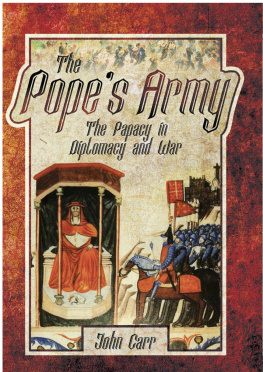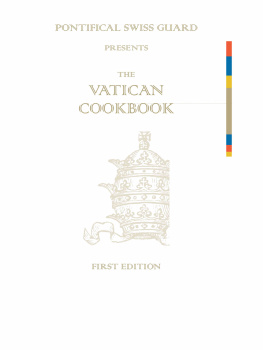The Popes' Secret Plot to Capture Rome from the New Italian State
HOUGHTON MIFFLIN COMPANY
BOSTON NEW YORK
2004
To little Sammy Bear
with hopes for the next generation
Copyright 2004 by David I. Kertzer
ALL RIGHTS RESERVED
For information about permission to reproduce selections from
this book, write to Permissions, Houghton Mifflin Company,
215 Park Avenue South, New York, New York 10003.
Visit our Web site: www.houghtonmifflinbooks.com.
Library of Congress Cataloging-in-Publication Data
Kertzer, David I., date.
Prisoner of the Vatican : the popes' secret plot to capture
Rome from the new Italian state / David I. Kertzer.
p. cm.
Includes bibliographical references (p.) and index.
ISBN 0-618-22442-4
1. Pius IX, Pope, 17921878. 2. Leo XIII, Pope, 18101903. 3. Garibaldi,
Giuseppe, 18071882. 4. Roman question. 5. PopesTemporal
power. 6. Church and stateItaly. 7. Rome (Italy)Annexation
to Italy, 1870. 8. Rome (Italy)History18701945. I. Title.
DG 798.7. K 47 2005 945'.63084dc22 2004054097
Printed in the United States of America
BOOK DESIGN BY ROBERT OVERHOLTZER
MAPS BY JACQUES CHAZAUD
QUM 10 9 8 7 6 5 4 3 2 1
Contents
LIST OF MAPS AND ILLUSTRATIONS
PROLOGUE
Introduction: Italy's Birth and Near Demise
1. Destroying the Papal States
2. The Pope Becomes Infallible
3. The Last Days of Papal Rome
4. Conquering the Holy City
5. The Leonine City
6. The Reluctant King
7. Pius IX in Exile Again?
8. The Papal Martyr
9. Anticlericalism in Rome
10. Two Deaths
11. Picking a New Pope
12. Keeping the Bishops in Line
13. The Pope's Body
14. Rumors of a French Conspiracy
15. Preparing for Exile
16. Hopes Dashed
17. The Bishops' Lament
18. Fears of a European War
19. Giordano Bruno's Revenge
20. The Pope's Secret Plan
Epilogue: Italy and the Pope
ACKNOWLEDGMENTS
NOTES
REFERENCES CITED
ILLUSTRATION SOURCES
INDEX
Maps and Illustrations
MAPS
Italy on the Eve of Unification and Garibaldi's 1860 Expedition
The Taking of Rome, 1870
Rome and the Leonine City, 1870
Rome: Pius IX's Funeral Procession, 1881
Europe, 1881
ILLUSTRATIONS follow
Pius IX with his court, 1850s
Cardinal Antonelli in the 1850s
Giuseppe Garibaldi, 1860
"Saint Giuseppe Garibaldi"
Victor Emmanuel II, proclaimed king of Italy
Cartoon: King Victor Emmanuel II rescues Rome from the grasp of Pope Pius IX
Cartoon: putting the papal tiara on a skeleton
Pius IX engraving, with signature
Cartoon: "The Sickly Temporal Power"
Cartoon: the Vatican Council, 1870
Cartoon: the Vatican Council proclaims papal infallibility
Giovanni Lanza, 1870 Napoleon III, ca. 1870
Giovanni Mazzini, imprisoned at Gaeta, 1870
Ferdinand Gregorovius
General Hermann Kanzler
Porta Pia after Italian troops' assault on Rome
Pius IX with foreign ambassadors as cannons fire on Rome, September 20,1870
General Nino Bixio
Harry von Arnim, Prussian ambassador to the Holy See St. Peter's Square as papal troops leave, September 21,1870
Catholic image: Pius IX prays in a boat in stormy seas
Catholic image: Imprisoned Pius IX, praying to the Madonna
Cartoon: Prime Minister Lanza moves to Rome as the pope is forced out
King Victor Emmanuel II on his deathbed, January 1878
The Pantheon, site of Victor Emmanuel II's funeral, January 1878
Pius IX's body on display in St. Peter's, February 1878
King Umberto I as a young man
Leo XIII at his writing desk, 1878
Cartoon: reconciliation of dead king and pope in heaven
Cartoon: continued strife of new king and pope on earth
Cardinal Mariano Rampolla
Luigi Galimberti, as cardinal
Father Luigi Tosti
Mons. Giacomo Della Chiesa, ca. 1887
Alberto Mario, anticlerical firebrand
Giovanni Bovio
Chancellor Bismarck addressing the German Reichstag
Francesco Crispi as prime minister
Wilhelm II, German emperor
Bismarck and Wilhelm II, October 30,1888
The dedication of the statue to Giordano Bruno, Rome, 1889
Prologue
T HE PRIME MINISTER could no longer deny the obvious: a political disaster was taking place in the streets of Rome. The small, private funeral procession carrying Pius IX's mortal remains to their final resting place was turning out to be neither small nor private. As midnight approached, he learned that 100,000 people had converged on St. Peter's Square, spilling into the surrounding streets. Agostino Depretis, who had come to power five years earlier in the historic victory of the left, had agreed to the late time, thinking that a procession at that hour would attract less public attention. He now saw how wrong he had been. How could he not have realized the potential for pandemonium in the dark? Outside the great basilica of St. Peter's, in the flickering light cast by their torches, stood the massive crowd of rosary-carrying, prayer-chanting devotees of the last pope-king. The prospect that thousands of loyal partisans of Rome's deposed pontifical ruler were about to try to march through the heart of the city made the elderly Depretis shudder.
For years now, the government had banned all Church processions in the Holy City, deeming them a threat to public order, a dangerous provocation to patriotic Italians. Yet, as the midnight bells rang, the coffin containing the pope's body emerged from St. Peter's, leading a procession such as Italy would never see again.
Scores of police surrounded the four official horse-drawn carriages as they began to move out. Two hundred carriages of the wealthiest Catholic faithful formed a line behind them, followed by three thousand candle-bearing marchers chanting Latin and Italian prayers and reciting the rosary. But the solemn mood did not last long. Scores of anticlericssome screaming angrily, some playfully if maliciouslyset upon the marchers and tried to drown out their prayers. Angered by the effrontery of the scabrous anticlerical songs and enraged by the cries of "Long Live the King!," "Long Live Garibaldi!," and "Long Live the Army!," some of the faithful, unable to restrain themselves, took up the defiant cry "Long live the pope!"
As the procession approached the SantAngelo bridge, which links Rome's right bank, home of the Vatican, to the main part of the city, on the left, policemen struggled haplessly to keep the anticlerics away from the processioners. Ominously, as the pontiff's body neared the ancient bridge, shouts of "Into the river with the pope!" and "Toss him in the river!" rose from the anticlerical ranks. "It was only through God's extraordinary protection," Turin's Catholic newspaper would later report, "that those venerated bones were not thrown into the Tiber."
The procession moved toward the heart of Rome, where windows displaying glowing lanterns in honor of the defunct pope were smashed by well-aimed stones. Squads of soldiers, held in reserve for just such an eventuality, found themselves unable to make their way to the scenes of violence because the narrow streets were so packed with the devout, the irreverent, and the simply curious. Before long, the anticlericals' rocks began to hit their first human targets, one finding a particularly exalted mark in the face of the nephew of Pius IX's successor, Leo XIII.
For the faithful, the sacrilege could hardly have been greater, and accounts of the outrages en route would fuel Catholics' anger worldwide. This was, after all, a funeral procession for the beloved pope who had reigned longer than any of his predecessors, longer than even St. Peter himself. The stories were horrifying: "Among the assailants," we learn from a typical Catholic report, "was one who, to add some sort of bizarre bravado to their cruel deeds, tore a torch from a pious citizen without warning and then rammed it into the face of a noble maiden who was so engrossed in reciting her prayers that she had been oblivious to the outside world."
Next page









